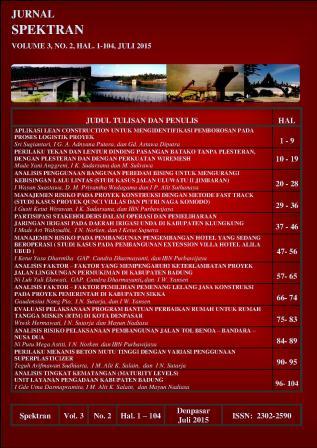PERILAKU TEKAN DAN LENTUR DINDING PASANGAN BATAKO TANPA PLESTERAN, DENGAN PLESTERAN DAN DENGAN PERKUATAN WIREMESH
Abstract
Concrete blocks are one of the common materials used in construction practice because they are quite easy to get and the price is relatively cheap. Masonry (either concrete blocks or bricks) is a structure consisting of a binding material (mortar) and a filler material (such as concrete blocks). In general, masonry is very good at resisting gravity loads, but not quite good at resisting shear loads such as loads generated by earthquakes, so it requires reinforcement in the form of plaster and additional wire mesh in the plaster of the masonry. Due to several problems of the masonry frame structure, it is necessary to conduct a research on the quality of the masonry to find out the compressive and flexural behavior of the masonry with reinforcement namely plaster and wire mesh.
The method used in this study was laboratory testing by creating specimens of concrete block masonry. Variations of masonry for compressive tests in this study 3 specimens varied based on the orientation namely Type A (Horizontal), Type B (Vertical) and Type C (Diagonal), and 3 specimens varied based on the treatment: masonry without plaster (TP), masonry with plaster (DP), and masonry with wire mesh reinforcement (DPW). Variations of masonry for bending tests perpendicular to the bed joint (LA) and parallel to the bed joint (LB).
Based on the results the crack patterns occurring in the specimens were relatively the same, where the initial cracks occurred predominantly in the interface area between the mortar and concrete blocks. The compressive strength of the concrete block masonry with plaster had a higher value than that of with wire mesh reinforcement. This was due to adhesion between the mortar and wire mesh and poor density so the performance of wire mesh was less effective. The concrete block masonry of Type C had the highest modulus of elasticity value. This was because the propagation of cracks that occurred in the masonry of Type C was slowed down by the position of the concrete blocks, which were installed with a slope of 45o. Meanwhile, the propagation of cracks of Type A and Type B occurred vertically in the interface between the mortar and concrete blocks. Flexural strength values ??of specimens that were perpendicular to the bed joint (LTPA, LDPA, and LDPWA) were much higher than that of parallel to the bed joint (LTPB, LDPB and LDPWB). The addition of the wire mesh reinforcement to the compressive load did not contribute much to the stiffness of the masonry. Meanwhile in the bending tests, the addition of wire mesh reinforcement resulted in an increase in the flexural strength values of the concrete block masonry.




